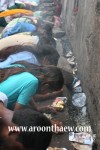This is a travel story from some years back about a visit to a rather peculiar temple. So take a ride to the Temple of the Possessed…. Ashok was a great driver.
We are on our way to Balaji Mandir, a temple dedicated to the mighty monkey king Hanuman, who rescued Sita, Ram’s wife, from Lanka, a tale from the Ramayana, a tale known by virtually everyone in India.
Ashok, our driver, has been there twice with his wife and child and is enthusiastic, “On Saturday it is most busy. There will be many people, from Haryana, from Delhi, from the Punjab. They come from all over to make a puja for Hanuman. It is a most famous temple in Rajasthan.”
Balaji Mandir is more than a family outing – this Rajasthan temple is a ladder between heaven and hell, between joy and despair. Twice a week, people come here to have their demons exorcised.
It’s 7am and we are slowly rolling through early morning traffic out of Jaipur, Rajasthan’s state capital. Ashok, who once worked for the US Embassy and drove Chelsea Clinton around India during her father’s state visit, is relaxed behind the wheel of his gleaming white Ambassador, as we clear the city gates and the ubiquitous urban traffic chaos.
Ashok knows his temples and has made pilgrimages to Hindu religious sites all over India. But Balaji Mandir, on the main Jaipur to Agra Highway, right in the heart of India’s tourist triangle, is especially close to his heart, “It is very good temple, so many people go there every Saturday and Tuesday, but maybe foreigners don’t know about this place.”
About a 100 km east of Jaipur, we slow down at a traffic crossing clogged with cars, buses, rickshaws, donkeys, camels and people. There’s no sign, but clearly this is our turn-off. The side road we take is lined with small shrines, ashrams and chai shops. Thousands of people are walking from the highway to the temple. Pilgrims and swamis of all ages swarm around us – half naked sadhus and old women with faded tattoos on their faces and arms, the nouveau riche with their mobiles and wives in jeans, farmer families that have just stepped off their fields.
It’s a welcome to India moment.
The Ambassador glides through the crowd, which like some fluid organic matter, only melts away as our vehicle passes. Ashok parks the car right in front of a souvenir shop selling cheap bangles and images of, naturally, Hanuman – in all shapes and sizes, battery driven or hand-powered, in wood, glass, plastic or horn, at a mind-boggling range of prices. We are in a religious supermarket. The shop owner protests about our choice of parking space, but Ashok, a big man, shouts something, points at us and we let ourselves be swept into the current of people.
A fair chunk of the subcontinent’s population appears to be moving around us and we move along swiftly, as if in anticipation, in a crowd of pilgrims and beggars until we reach the main temple – a bland two-story building that reveals nothing special whatsoever.
There’s a queue of about a thousand people out front, driven into a narrow corralled corridor by temple security and a few desultory cops. The sun’s up, it’s hot as hell and the ground is caked with food, sweat and prashad – sweets from the temple. The queue is so long that many will have to wait for hours before they reach the temple gate. By now we have attracted a sizable crowd – about a hundred people – of beggars, street kids, sadhus and a few other determined nut undefinable seekers.
As the pressure to see, talk to and touch the aliens is about to reach fever pitch, we are rescued by an old skinny gentleman dressed in a thin kurta. This most innocious-looking individual clearly has authority and he knows who we are – how this could be so, I cannot ascertain, because we have only just arrived, but I put it down to Ashok’s feverish networking with a group of hustlers and sadhus.
We make straight for the VIP gate (all crowded temples in India have one), an iron bar is pulled back, a chain comes up and 2000 eyes follow us with a mix of envy, curiosity, and laughter as we are led into an office – to meet a temple official who eyes us with neutral curiosity.
“Which country?” he suddenly shouts.
He shakes his head looking at the photographer, Aroon, a Thai, “She not Germany.”
The meeting ends. We follow Ashock deeper into the temple.
Behind us the noise level increases rapidly. The man in charge of the chain at the temple entrance has just opened the floodgates. Thousands are straining to enter – it feels like the summer sales – and are pushing as if the deity was present for a limited period of time only.
We are led through a side entrance to the main inner sanctum – which looks like a prison. Pilgrims are squeezed double file onto a narrow walkway until they reach a set of bars. Beyond the bars is a silver box – for donations – and beyond that, a glass wall. Hanuman, flanked by Shiva and Parvati to his right and Krishna to his left, is just visible from where we are standing.
None of the pilgrims mind herded through the temple like cattle, that they will throw part of their hard-earned savings into the box and that in less than ten minutes they will be outside again, heading for their bus to take them back to their village. Plastic bags of lose change are handed to grim faced Brahmin priests beyond the iron bars, who dump them in the big silver box. The pilgrims are given prashad, a blessed sweet, and despite the hours waiting and crush, they head happily for the exit.
We move through the bowels of the temple complex until we reach a concrete stairway that leads into a long dark hall on the second floor. Men and women sit in small groups, in circles around one person, usually a woman, who is nodding back and fourth. Little light falls into the room through a row f obarred windows .
Some scream, others mumble. A few women are convulsing all by themselves.
The pilgrim crowd around us moves through this long, long room and I try and make out exactly what is going on in the semi-darkness – human beings on a shadowy trip through trance-land inhabit this upper story. The shakti is strong – the strange journey is only taken by women.
The pilgrims around us carry large brass trays of cooked rice on their heads, ignoring the possessed and their realtives. The crowd is so dense and so homogenous, there is no opportune moment to stop in the current and we are pushed through a small door into the morning sun. But the sun doesn’t belong here.
We are around the back of the temple. The smell of something rotten is so strong, I am almost gagging. Ashok, wisely, has his handkerchief on his face already. On a small courtyard immediately in front of us, men dump rice onto the floor, which is already covered in a thick (about a meter thick) layer of rice by earlier pilgrims. A small army of women with long brushes is getting rid of some of these donations but they are most concerned with pocketing as much baksheesh as possible and the bulk of the food, mixed with prashad, sticks to our bare feet. Dogs scavenge in the rubbish that lies everywhere. Ashok leads us along the back temple wall.Here the most extraordinary activities take place – a scene so blissfully insane, any doubts one might harbour on India’s unique eccentricities fading away, are immediately swept away.
About a dozen women have prostrated themselves facing the temple wall and a shallow ditch full of refuse. Immediately in front of their faces, which are very close to the grime encrusted, filthy ground, they have placed a smoldering piece of dry cow shit – a traditional cooking fuel. Each cowpat has had some prashad (sacred sweets) and ghee (clarified butter) placed on top and the air is filled with a smell that is nothing short than apocalyptic.
The men and women in prayer are berated by supervisors who walk the line behind them, sometimes pressing a pilgrim’s head closer to the ground while encouraging the rest to pray vigorously. Several younger girls are crying and retching, but no one breaks ranks. We follow the line of these unfortunates who are clearly possessed by something, until we reach the truly destitute and demented – old women who have had enormous granite boulders laid on their hands, feet or their heads. Most are all but immobile, as they are inhaling cow shit.
Beyond the building a stairway leads up a steep hill. This denuded and filthy hillside is covered in small shrines, mostly crudely fashioned from concrete and a few cheap tiles. Amongst the shrines, the truly insane rule supreme.
“The women have heavier medium, the men only light,” Ashok explains.
Indeed up here the women are also in a majority – the only competition are the overfed and aggressive monkeys – this is after all a temple dedicated to Hanuman.
The ground between the shrines is covered in rotten food, several inches thick. A young woman is front of us has placed her cowpat on a shrine. As she sucks in the noxious fumes, she babbles and screams intermittently, before she’s back to inhale the burning bovine feces.
A shallow pool a little further down the ravine is filled with what looks like an entire family. Old women sit waist deep in water and splash about like small children, babbling and crying, while the dogs and monkeys are in a permanent state of combat readiness, prepared to fight to the death for the next bit of fresh food to be dumped around them.
By now our feet are encrusted in sacred filth and the smell of rotten sacrifice has seeped deep into our skin, hair and clothes. Ashok of course, is enjoying every moment of this.
As we leave, Aroon raises her camera to an old lady whose hands are stuck between several heavy boulders. The woman notices and howls at the passing crowd.
“Camera, camera.”
Ashok makes for the stairway to freedomt at double speed and we follow suit.
Luckily it’s not over yet. A narrow corridor between two buildings takes us back to street level. Sadhus and professional beggars occupya narrow corridor that takes us back to street level, their bowls at the ready, hoping for generosity from the pilgrims. We are flushed out into the world – a crowded, immensely crowded street, crammed with thousands of smiling and shouting devotees, perplexed to have a couple of foreigners amongst them.
All images by Aroon Thaewchatturat.



